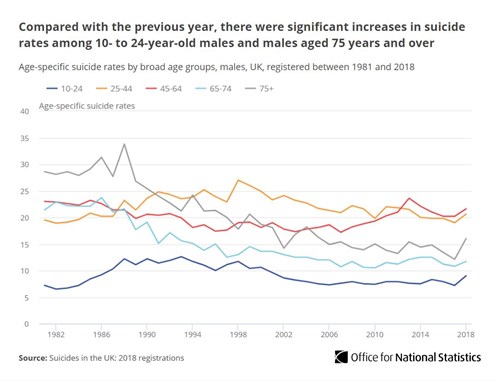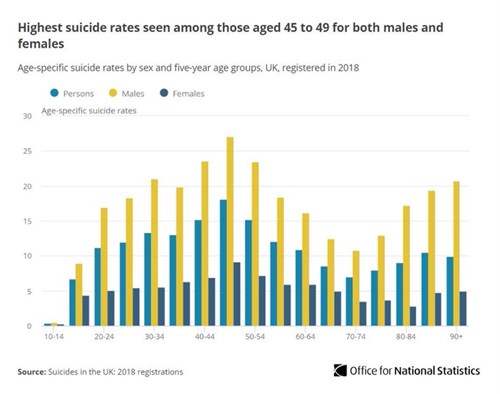The rate of suicide in the UK in 2018 was significantly higher than 2017. This is the first increase since 2013
Date: Tuesday 03 Sep 2019
A view on the new Office for National Statistics suicides in the UK: 2018 registrations.
We’re hugely concerned by the latest ONS report on suicide, it represents the first increase in the rate of suicide in the UK since 2013. In 2018, 6,507 lives were lost to suicide in the UK and, again, three-quarters of those deaths registered were male – something that has existed since the 1990s. It’s too early to be able to identify if this increase is part of a larger societal trend, but from a Scottish point of view, the report certainly makes for very difficult reading today.
We are contacted by people affected by this issue on a regular basis, and can plainly see the pain so many of them experience after losing a loved one through suicide. This report highlights the scale of the issue and brutally illustrates that, while great strides have been made around mental health and suicide awareness in recent years, this issue is not going away. Now more than ever, we must acknowledge this and act with urgency, with new thinking and new strategies because the chance of it happening to someone you know is getting higher.
Registered deaths in the UK from suicide.
UK male suicide rate increased significantly in 2018
Males continue to account for three-quarters of suicide deaths in 2018 (4,903 male deaths compared with 1,604 female deaths). The latest increase in the overall UK rate appears to be largely driven by males: in 2018, the rate was 17.2 deaths per 100,000 males, up significantly from the lowest observed rate in the previous year (15.5 deaths per 100,000).
Suicides by country
In line with previous years, Scotland had the highest suicide rate in GB in 2018, with 16.1 deaths per 100,000 persons (784 deaths), followed by Wales with a rate of 12.8 per 100,000 (349 deaths). England had the lowest rate with 10.3 deaths per 100,000 (5,021 deaths). The latest 2018 figures for Northern Ireland will be published by the Northern Ireland Statistics and Research Agency later this year.

Some Main Points.
- In 2018, there were 6,507 suicides registered in the UK, the latest rate is significantly higher than that in 2017 and represents the first increase since 2013.
- Three-quarters of registered deaths in 2018 were among men (4,903 deaths), which has been the case since the mid-1990s.
- The UK male suicide rate of 17.2 deaths per 100,000 represents a significant increase from the rate in 2017
- Scotland had the highest suicide rate in GB with 16.1 deaths per 100,000 persons (784 deaths), followed by Wales with a rate of 12.8 per 100,000 (349 deaths) and England the lowest with 10.3 deaths per 100,000 (5,021 deaths); figures for Northern Ireland will be published later this year by the Northern Ireland Statistics and Research Agency.
- Males aged 45 to 49 years had the highest age-specific suicide rate
- As seen in previous years, the most common method of suicide in the UK was hanging, accounting for 59.4% of all suicides among males
Nick Stripe, Head of Health Analysis and Life Events, said:
“We saw a significant increase in the rate of deaths registered as suicide last year which has changed a trend of continuous decline since 2013. While the exact reasons for this are unknown, the latest data show that this was largely driven by an increase among men who have continued to be most at risk of dying by suicide.
UK male suicide rate increased significantly in 2018
Suicides in the UK
In 2018, a total of 6,507 suicides were registered in the UK, 686 more deaths than in 2017 when there were 5,821 deaths (11.8% increase). This equates to a statistically significant increase in the suicide rate, with 11.2 deaths per 100,000 population in 2018, compared with 10.1 deaths per 100,000 population in 2017.
Following several years of decline, the latest UK suicide rate has increased to the level seen when it previously peaked in 2013 (11.1 deaths per 100,000). Suicide rates tend to fluctuate on a year-to-year basis. It is therefore too early to say whether the latest increase represents a change in the recent trend.
Scotland, in recent years, had one of the largest decreases in the male suicide rate. In 2014, the rate was 20.2 deaths per 100,000 (497 deaths); this was the lowest rate observed since the time series began. Since then, the suicide rate for males in Scotland has increased significantly to 24.5 deaths per 100,000 in 2018 (a total of 581 deaths).
In England, a total of 3,800 deaths were registered as suicide among men in 2018, up 14% from the total in 2017 (3,328). This equates to a statistically significant increase in the England male suicide rate, with 15.9 deaths per 100,000 males in 2018, compared with 14.0 deaths per 100,000 males in 2017. The latest rate remains statistically lower than that observed in 1981 when there were 19.3 deaths per 100,000 males in England.
Across time, the male suicide rate for Wales shows a volatile pattern owing to the relatively smaller number of deaths. At the beginning of the time series in 1981, the rate was 16.0 deaths per 100,000 (165 deaths); this is not significantly different from the rate seen in 2018 (19.1 deaths per 100,000; a total of 252 deaths).
The male suicide rate in Northern Ireland was generally consistent between 1981 and 2004, and it has again been mostly consistent between 2006 and now, with fluctuations because of the relatively small numbers. The large increase seen in Northern Ireland between 2004 and 2006 coincides with a change to the Coroners Service.

Significant increase in suicide rates for males aged 10 to 24 years and males aged 75 years and over since 2017.
From 1981 to 1990, males aged 75 years and over had the highest age-specific suicide rate. Since then, suicide rates among this group fell the most to their lowest point in 2017 when there were 12.1 deaths per 100,000 males (277 deaths). 2018 saw the biggest increase in suicide rate among males aged 75 years and over, when compared to all other age groups; this is 32% higher (16.0 deaths per 100,000 males; 376 deaths) than the suicide rate in 2017.
Over time, males aged 10 to 24 years have always had the lowest suicide rates. However, following a period of recent stability in the suicide rate for this group, in 2018 their suicide rate increased to 9.0 deaths per 100,000 males (542 deaths), up 25% from 7.2 deaths per 100,000 males in 2017 (431 deaths).
From 1991 to 2012, males aged 25 to 44 years tended to have the highest suicide rates. Since 2013, males aged 45 to 64 years have had the highest age-specific suicide rates with 21.6 deaths per 100,000 population in 2018.
Generally, higher rates of suicide among middle-aged males in recent years might be because this group is more likely to be affected by economic adversity, alcoholism and isolation; furthermore, it could be that this group are less inclined to seek help. As well as being the most likely to die by suicide.

More info HERE

